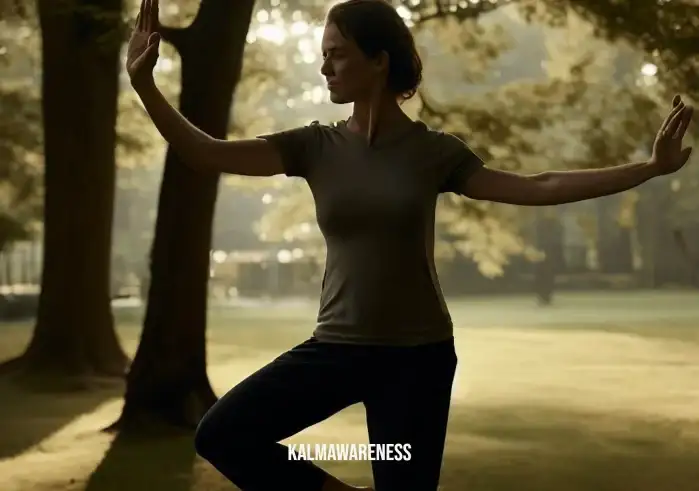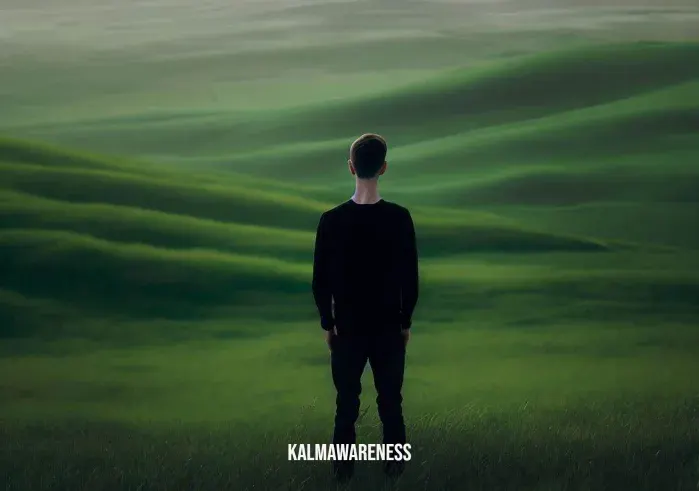A Journey Towards A Sense of Stability
A sense of stability, an invaluable asset to human existence, offers us the foundation to lead a life rooted in equilibrium and peace. In the tumultuous ebb and flow of life’s uncertainties, cultivating a sense of stability nurtures our ability to remain calm, grounded, and secure.
Through the practice of mindful balance, we can discover the essence of stability in our daily lives. But this journey towards stability doesn’t occur in a vacuum; it’s a multifaceted experience intricately woven into various aspects of our existence, such as emotional health, mental resilience, physical wellness, and spiritual growth.
Unraveling the Fabric of Stability
The Root of Stability: Groundedness
Groundedness forms the bedrock of a sense of stability. It’s about finding your sitting down base in the midst of life’s whirlwinds. By grounding ourselves, we anchor our mind and body to the present, liberating us from the shackles of past regrets and future anxieties.
It’s akin to adopting the eye of the hurricane meditation, wherein, despite the chaos that surrounds us, we remain serene and undisturbed at the center. This state of serene stability is not about resisting or escaping the storm but being steadfast amidst it.
Groundedness is not a mere concept, but a felt experience. It is the sweet serenity in the eye of life’s storm, a potent testament to our inherent resilience and adaptability.
Physical Stability: A Balancing Act
Our physical well-being significantly impacts our sense of stability. Ensuring physical balance, much like maintaining a wise mind-body meditation, contributes to a well-rounded sense of stability.
Taking the metaphor of how to keep your seat when riding a horse, we need to be in tune with our bodies to maintain balance, essentially fostering our sense of stability.
Physical practices like mindful pilates and yoga further enhance our balance. By integrating body movements with conscious breathing, mindful pilates and yoga facilitate a harmonious balance between our physical and mental states, thereby fostering our sense of stability.
Emotional Stability: Navigating the Sea of Feelings
Emotional stability is another essential aspect of our overall stability. Here, anchoring meditation plays a crucial role. Anchoring in meditation is akin to an anchor for a ship; it helps us hold steady, even amidst the stormiest emotional seas.
Furthermore, dealing with strong emotions like jealousy requires mindful attention. By viewing our pictures of jealousy from a mindful perspective, we can ensure they do not shake our sense of stability.
Let this first chapter serve as an introduction to the comprehensive spectrum of stability. While we have started with grounding ourselves, balancing our physical state, and navigating our emotional world, the journey doesn’t end here.
Join us in the next part of this exploration, where we’ll delve into mental stability, spiritual stability, and the role of practices like balance meditation, chakra balancing, and more in establishing a sense of stability.

Nurturing Mental and Spiritual Stability
Having established the importance of groundedness, physical balance, and emotional equilibrium, it’s crucial to extend the notion of a sense of stability to the realms of our mental and spiritual lives. Our journey towards stability is like a tree, with groundedness as its roots, physical and emotional balance forming the trunk, while mental and spiritual stability blossom as the leaves and fruit, respectively.
Mental Stability: The Teflon Mind
Cultivating mental stability involves developing what we call a ‘teflon mind’. Just as a Teflon-coated pan allows food to glide off without sticking, a Teflon mind lets experiences, thoughts, and emotions pass through without causing lingering disturbances. It is a cognitive quality that involves resilience, adaptability, and a non-reactive response to experiences, particularly stressors.
There are several effective strategies for cultivating a Teflon mind and, thus, mental stability.
- Mindfulness Meditation: This method involves paying attention to the present moment non-judgmentally. The practice of balance meditation, for instance, can help enhance mental stability.
- Emotional Regulation: Understanding and managing your emotions can lead to mental stability. Techniques like tapping meditations serve as valuable tools for this.
- Cognitive Reappraisal: This involves changing the way we interpret an emotional stimulus. Learning how to cognitively reappraise situations can make our mind more like Teflon, allowing stressors to slide off easily.
Spiritual Stability: Rooting in our Essence
When discussing spiritual stability, the concept of chakra balancing becomes pertinent. Chakras are energy centers in the body, and when balanced, they contribute to our overall stability. The root chakra, or the ‘Muladhara’ chakra, plays a crucial role here.
Practices to enhance spiritual stability involve the following steps:
- Grounding Techniques: These help us connect with the earth and our bodies, promoting spiritual stability. One such technique is testicle breathing, a Taoist practice that circulates energy throughout the body.
- Chakra Meditation: Techniques like bija mantra ‘Lam’ help balance the root chakra, fostering a sense of spiritual grounding and stability.
- Mind-Body Practices: Yoga and tai chi are excellent ways to enhance spiritual stability. Smiling mind corporate is an example of a program that combines mindfulness and yoga for holistic spiritual stability.
Stability: A Holistic Perspective
A holistic view of stability would not be complete without recognizing how these different aspects intersect and interact with one another. The table below summarizes these dimensions of stability, their characteristics, and some practices to enhance them:
| Stability Aspect | Characteristics | Practices |
|---|---|---|
| Groundedness | Feeling of being connected to the present | Eye of the hurricane meditation, sitting down base |
| Physical Balance | Harmony between the body and mind | Wise mind-body meditation, mindful pilates and yoga |
| Emotional Stability | Non-reactive response to emotional stimuli | Anchoring meditation, mindful examination of emotions |
| Mental Stability | Resilience, adaptability, non-reactive response to experiences | Balance meditation, tapping meditations, cognitive reappraisal |
| Spiritual Stability | Connection to the higher self and universe | Grounding techniques, chakra meditation, mind-body practices |
In this second chapter, we have delved into the nuances of mental and spiritual stability and their role in establishing a robust sense of stability. Remember, cultivating stability is a lifelong process. But with persistence, you can build a stable, balanced, and serene life.
In the next part of the article, we’ll explore how certain conditions, like bipolar disorder, can influence our sense of stability and what we can do about it. We will also delve into the role of protective measures such as the bubble of protection in maintaining stability.

The Influence of Bipolar Disorder and the Role of Protective Measures in Achieving a Sense of Stability
As we delve deeper into understanding the sense of stability, it’s crucial to recognize the impact of specific conditions on our stability. One such condition is bipolar disorder. Simultaneously, we need to understand the various protective measures one can adopt to maintain stability.
The Impact of Bipolar Disorder on Stability
Bipolar disorder, previously known as manic-depressive illness, is a mental health condition that causes extreme mood swings. These can include emotional highs (mania or hypomania) and lows (depression). The shifting moods and energy levels that characterize bipolar disorder can disrupt one’s sense of stability significantly.
The relationship between bipolar disorder and meditation is complex yet enlightening. With its roots in creating harmony between the body, mind, and spirit, meditation can play a crucial role in managing bipolar disorder symptoms. This idea aligns with the words of the famous writer Virginia Woolf who said, “Every secret of a writer’s soul, every experience of his life, every quality of his mind, is written large in his works.” Like a writer’s journey, meditation allows a deeper exploration of one’s mind and may offer a path toward the elusive sense of stability for those battling bipolar disorder.
Protective Measures to Enhance Stability
Understanding the impact of conditions like bipolar disorder leads us naturally to a discussion about protective measures. One such protective measure is the Bubble of Protection, a spiritual tool used for shielding oneself from external influences. This tool enables us to create a sense of stability within ourselves, irrespective of the external circumstances.
This concept resonates with the quote by the philosopher Marcus Aurelius, “You have power over your mind – not outside events. Realize this, and you will find strength.” The Bubble of Protection method helps us to exert control over our inner world, creating a refuge of stability even amidst life’s storms.
There are several other protective measures that we can adopt to build our sense of stability:
- Chakra Protection: Our chakras, or energy centers, are vulnerable to external influences. Ensuring that they are protected helps maintain our internal equilibrium. A comprehensive understanding of chakra protection can thus be beneficial.
- Grounding Techniques: Grounding techniques, such as anchoring breath, can serve as protective measures by helping us stay connected to the present moment, a fundamental aspect of stability.
- Emotional Regulation: Strategies like jealous scenarios can be used to navigate intense emotions, protecting our emotional balance, and promoting a sense of stability.
In this chapter, we have delved into the influence of bipolar disorder on stability and the protective measures one can use to enhance it. Remember, as Buddha once said, “Peace comes from within. Do not seek it without.” This peace, this sense of stability, comes from a deep understanding of oneself and one’s circumstances, and the consistent application of practices that foster stability.
In the next part of the article, we will delve into the role of various holistic healing methods in enhancing our sense of stability, such as the Kundalini meditation and Amygdala healing, and explore how stability can be encouraged in the corporate world through techniques like the Smiling Mind Corporate program.

Holistic Healing Approaches and Corporate Mindfulness Techniques: Paving the Path to Stability
As we continue exploring the concept of a sense of stability, let’s journey into holistic healing approaches like Kundalini meditation and Amygdala healing. These techniques can bolster our mental resilience and foster a stable mindset. Additionally, let’s discuss how corporate programs like Smiling Mind Corporate bring about equilibrium in the professional world.
Kundalini Meditation and the Path to Stability
Kundalini meditation is an ancient practice focusing on awakening the dormant, spiritual energy within us, known as the Kundalini. The process, involving the alignment and balancing of chakras, can profoundly impact our emotional and mental stability. The addiction meditation Kundalini technique is particularly helpful in breaking free from harmful patterns, thereby enhancing stability.
Pablo Picasso said, “Everything you can imagine is real.” Kundalini meditation channels this idea, using visualization to create a real and lasting sense of stability.
Amygdala Healing: Rewiring Emotional Responses
The Amygdala, a tiny almond-shaped structure in our brain, plays a crucial role in emotional processing. It’s often referred to as the “fight or flight” center of the brain. However, when overactive, the Amygdala can lead to chronic stress and emotional imbalance. Amygdala healing techniques are designed to soothe this overactivity, facilitating emotional stability.
In the words of inspirational author Roy T. Bennett, “Change is the end result of all true learning.” By learning to alter our Amygdala’s responses, we can change our emotional landscape, fostering a deep sense of stability.
The Role of Corporate Mindfulness Programs in Promoting Stability
In the hustle and bustle of corporate life, maintaining mental stability can be challenging. Fortunately, mindfulness programs designed for corporate environments, such as the Smiling Mind Corporate program, provide techniques to reduce stress and enhance emotional resilience in the workplace.
Helen Keller, an extraordinary example of resilience and stability, once said, “We could never learn to be brave and patient if there were only joy in the world.” Corporate environments often challenge us, but through practices like mindfulness, we can transform these challenges into stepping stones towards greater stability.
| Techniques | Primary Focus | Potential Impact on Stability |
|---|---|---|
| Kundalini Meditation | Awakening dormant spiritual energy | Enhanced emotional and mental stability |
| Amygdala Healing | Soothing the “fight or flight” center of the brain | Reduced chronic stress and emotional balance |
| Smiling Mind Corporate | Mindfulness in the workplace | Lowered stress, enhanced resilience, and mental stability |
In this chapter, we dove into the world of Kundalini meditation, Amygdala healing, and corporate mindfulness techniques. These tools, when used effectively, can guide us towards a strong sense of stability. As we carry forth on our journey to stability, let’s remember the words of Haruki Murakami, “When you come out of the storm, you won’t be the same person who walked in. That’s what this storm’s all about.”
In the next part of our article, we’ll explore the practices of Mindful Pilates and Yoga, and how the philosophy of mindfulness integrates with our pursuit of balance and stability.

Integrating Movement and Mindfulness: The Foundation of Stability
As we delve deeper into the layers of sense of stability, we cannot ignore the powerful role of physical movement and mindfulness in grounding our mental space. Through practices like Mindful Pilates and Yoga, our body becomes an anchor, enabling us to explore and enhance our stability. Simultaneously, the role of energy clearing and understanding our mind-body connection through practices like Wise Mind Body meditation becomes evident.
Mindful Pilates and Yoga: Stability Through Movement
Pilates and Yoga, two timeless disciplines, combine physical movement with deep breathing and mindful awareness. Each posture or exercise demands balance, core strength, and mental focus. Regular practice enhances physical strength and flexibility, promoting a sense of stability. Mindful Pilates and Yoga are even more effective in grounding us.
Jane Goodall, renowned ethologist and anthropologist, once said, “What you do makes a difference, and you have to decide what kind of difference you want to make.” This sentiment rings true in our journey toward stability. Every mindful movement, every breath, makes a difference.
Energy Clearing for Stability
The concept of energy clearing stems from the understanding that our bodies and environments hold energy that can influence our mental and emotional state. Clearing blocked or stagnant energy can help restore balance and promote a sense of stability. Techniques of clearing energy blocks facilitate this process, guiding us towards equilibrium.
Lao Tzu, the ancient Chinese philosopher, understood the essence of stability. He said, “To the mind that is still, the whole universe surrenders.” When our energy is clear and balanced, our mind finds peace, and with it, a profound stability.
The Wise Mind Body Connection
The concept of the Wise Mind is central to dialectical behavior therapy (DBT), a form of psychotherapy that helps people cope with emotional instability. The Wise Mind Body meditation builds upon this concept, guiding us to connect with our body’s wisdom and fostering stability.
In the words of Jon Kabat-Zinn, “The little things? The little moments? They aren’t little.” Paying attention to our body’s signals might seem insignificant but can be a pivotal step towards stability.
In this chapter, we have unraveled the relationship between physical movement, energy clearing, the mind-body connection, and our sense of stability. As we journey towards stability, it’s beneficial to remember the words of Albert Einstein, “Life is like riding a bicycle. To keep your balance, you must keep moving.”
In the final part of our article, we’ll explore how chakra balancing and protective techniques, along with grounding techniques, contribute to our overall sense of stability and equilibrium.

Harmonizing Energies and Grounding Practices: Your Roadmap to Stability
As we culminate our exploration into the sense of stability, it is crucial to understand the more subtle dimensions of our existence that influence our groundedness. Techniques like Chakra Balancing and Protection, along with various grounding practices, play a vital role in creating an internal atmosphere of equilibrium and security.
Chakra Balancing and Protection: An Energetic Pathway to Stability
Our body comprises multiple energy centers, or chakras, each governing different aspects of our physical, emotional, and mental wellbeing. When these energy centers are in harmony, we experience a deep sense of stability. Practices like Chakra Balancing Meditation and Chakra Protection aid in aligning and protecting our chakras, respectively.
Rumi, the 13th-century Persian poet, beautifully captured the essence of this inner harmony, “The universe is not outside of you. Look inside yourself; everything that you want, you already are.” Chakra balancing allows us to tap into this internal universe and establish stability.
Grounding Practices: Stability Through Earth Connection
Grounding, or Earth connection, is a powerful practice that helps us cultivate a sense of stability. By consciously connecting with the Earth, we can absorb its nurturing and stabilizing energy, fostering groundedness. Techniques like Sit Up Foot Anchor and practices at the Fire and Earth Kitchen facilitate this Earth connection.
Thich Nhat Hanh, renowned Buddhist monk and peace activist, said, “Walk as if you are kissing the Earth with your feet.” This embodies the essence of grounding practices. Each step, each conscious connection with the Earth, reinforces our stability.
In our journey exploring the sense of stability, we’ve traversed through psychological aspects, body and mind integration, and energy alignment. We hope these insights offer you valuable tools to navigate life with greater balance and equanimity.
As Hermann Hesse, the celebrated German-born Swiss poet, novelist, and painter once said, “Within you, there is a stillness and sanctuary to which you can retreat at any time and be yourself.” Remember, your sense of stability is not an outside destination but an internal sanctuary accessible at any moment.
Feel free to delve deeper into our various collections, such as Personal Growth, Equilibrium, and many more for comprehensive guides, meditations, and articles designed to support your journey towards stability. Your journey to a balanced and stable life continues here at KalmAwareness, your trusted companion in personal growth and mindfulness.




